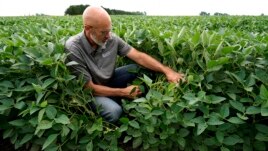06 September 2022
The Russian invasion of Ukraine six months ago led to worries that people worldwide would go hungry. Crops like wheat remained stuck in blockaded ports.
With only so much farmland in the United States, farmers could not do much to meet the new demand. But that may be changing.
Earlier this summer, the U.S. Department of Agriculture, USDA, started new policies to urge American farmers to grow two crops, one after another, on one piece of land. The practice is known as double cropping.

Jeff O'Connor checks soybeans at his farm, Thursday, Aug. 4, 2022, in Kankakee, Ill. A US Department of Agriculture move to change crop insurance rules to encourage farmers to grow two crops in a single year instead of one. (AP Photo/Nam Y. Huh)
The USDA changed insurance rules to lessen the risk of growing two crops. By doing this, the USDA hopes to greatly increase the amount of wheat that U.S. farmers can grow every year. That will reduce dependence on big wheat producers like Ukraine and Russia and increase supplies.
The idea has not received widespread attention. As autumn arrives, it is unclear how many farmers plan to try double cropping. But some farmers who already grow two crops say it is something others should consider.
"I think it's a great idea," said Illinois farmer Jeff O'Connor. He has double cropped for years and recently appeared with U.S. President Joe Biden to support efforts to increase food production. "How successful it will be, I don't know," he added.
In 2020, the U.S. exported wheat valued at $6.3 billion. The U.S., Russia, Australia and Canada lead the world in wheat exports. In past years, Ukraine has usually come in fifth place.
Ukraine is a leading supplier of wheat to people in Africa and the Middle East. After Russia's invasion, wheat prices nearly doubled to over $12 a bushel. Since then, prices have dropped following agreements that have permitted the export of some Ukrainian wheat.
Double cropping in warmer areas
Double cropping is not a new idea in the southern parts of the United States. The warmer temperatures there let farmers plant winter wheat that can be harvested in late spring while adding a second crop of soybeans. The problem comes when cool weather delays the spring harvest of wheat, which in turn delays the planting of soybeans.
With the new rules, the USDA could ease the risk of a costly planting backup. The agency would simplify crop insurance approvals for farmers planting a second crop in areas where double cropping is possible. It also would work with crop insurers and farm groups to support coverage in other areas.
In announcing its effort, the USDA said it was aiming to "stabilize food prices and feed Americans and the world amidst continuing challenges such as the COVID-19 pandemic, supply chain disruptions, and the invasion of Ukraine by Russia."
The USDA did not note climate change in its announcement. But the agency and other experts have long said warming temperatures will make farmers rethink what they grow and how.
Mark Lehenbauer raises livestock and grows crops near Palmyra, Missouri. He said he has double cropped for years. For him, it has been a good move financially. Still, he warns that farmers must learn how to plant one crop just as they need to harvest another.
Lehenbauer added that many farmers may not be willing to take on the added risks or the extra work. "There are a lot of extra steps in there," he said. "It adds some complexity."
I'm Ashley Thompson.
Scott McFetridge reported this story for The Associated Press. Hai Do adapted the story for Learning English.
____________________________________________________________________
Words in This Story
blockade - v. to stop supplies or people from entering or leaving
practice - n. the activity of doing something again and again
insurance - n. protection from bad things that may happen in the future
bushel - n. a unit for measuring an amount of fruit or grain
stabilize - v. to make steady
challenge - n. a difficult task or problem
livestock -n. farm animals, such as cows or pigs, that are kept and used by people